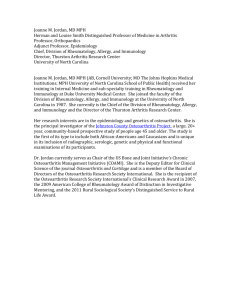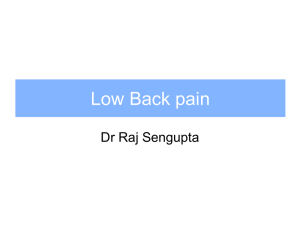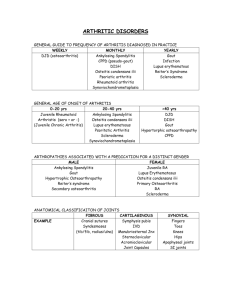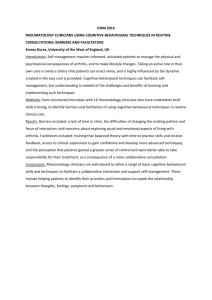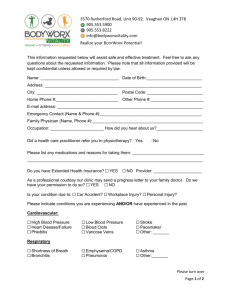Results - HAL
advertisement
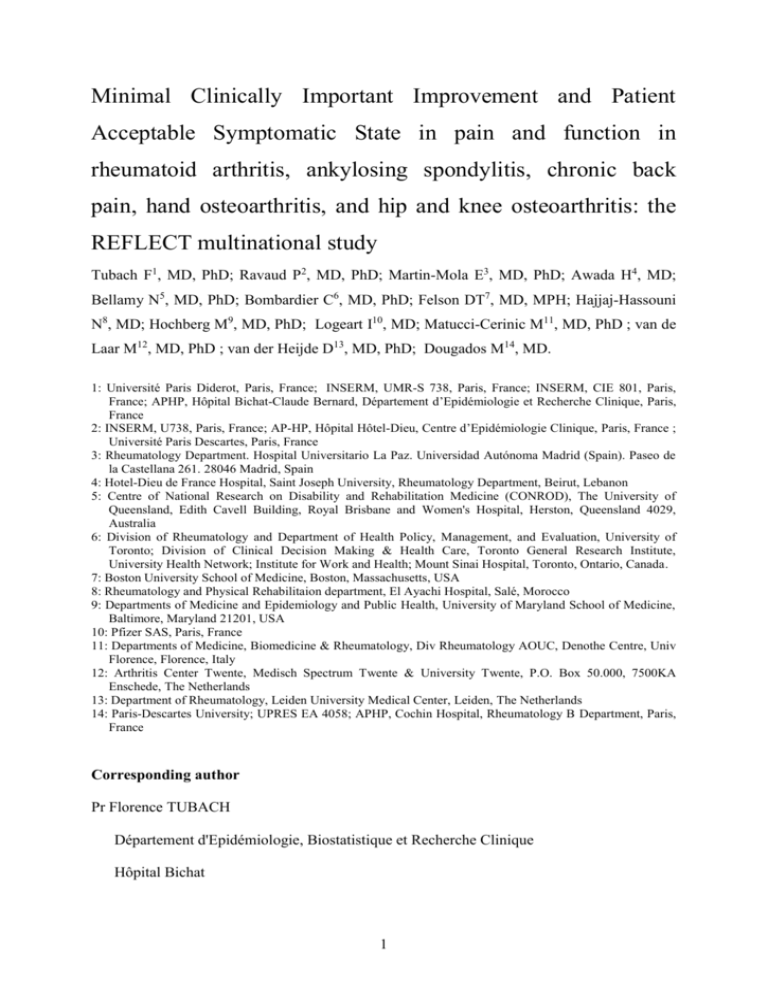
Minimal Clinically Important Improvement and Patient Acceptable Symptomatic State in pain and function in rheumatoid arthritis, ankylosing spondylitis, chronic back pain, hand osteoarthritis, and hip and knee osteoarthritis: the REFLECT multinational study Tubach F1, MD, PhD; Ravaud P2, MD, PhD; Martin-Mola E3, MD, PhD; Awada H4, MD; Bellamy N5, MD, PhD; Bombardier C6, MD, PhD; Felson DT7, MD, MPH; Hajjaj-Hassouni N8, MD; Hochberg M9, MD, PhD; Logeart I10, MD; Matucci-Cerinic M11, MD, PhD ; van de Laar M12, MD, PhD ; van der Heijde D13, MD, PhD; Dougados M14, MD. 1: Université Paris Diderot, Paris, France; INSERM, UMR-S 738, Paris, France; INSERM, CIE 801, Paris, France; APHP, Hôpital Bichat-Claude Bernard, Département d’Epidémiologie et Recherche Clinique, Paris, France 2: INSERM, U738, Paris, France; AP-HP, Hôpital Hôtel-Dieu, Centre d’Epidémiologie Clinique, Paris, France ; Université Paris Descartes, Paris, France 3: Rheumatology Department. Hospital Universitario La Paz. Universidad Autónoma Madrid (Spain). Paseo de la Castellana 261. 28046 Madrid, Spain 4: Hotel-Dieu de France Hospital, Saint Joseph University, Rheumatology Department, Beirut, Lebanon 5: Centre of National Research on Disability and Rehabilitation Medicine (CONROD), The University of Queensland, Edith Cavell Building, Royal Brisbane and Women's Hospital, Herston, Queensland 4029, Australia 6: Division of Rheumatology and Department of Health Policy, Management, and Evaluation, University of Toronto; Division of Clinical Decision Making & Health Care, Toronto General Research Institute, University Health Network; Institute for Work and Health; Mount Sinai Hospital, Toronto, Ontario, Canada. 7: Boston University School of Medicine, Boston, Massachusetts, USA 8: Rheumatology and Physical Rehabilitaion department, El Ayachi Hospital, Salé, Morocco 9: Departments of Medicine and Epidemiology and Public Health, University of Maryland School of Medicine, Baltimore, Maryland 21201, USA 10: Pfizer SAS, Paris, France 11: Departments of Medicine, Biomedicine & Rheumatology, Div Rheumatology AOUC, Denothe Centre, Univ Florence, Florence, Italy 12: Arthritis Center Twente, Medisch Spectrum Twente & University Twente, P.O. Box 50.000, 7500KA Enschede, The Netherlands 13: Department of Rheumatology, Leiden University Medical Center, Leiden, The Netherlands 14: Paris-Descartes University; UPRES EA 4058; APHP, Cochin Hospital, Rheumatology B Department, Paris, France Corresponding author Pr Florence TUBACH Département d'Epidémiologie, Biostatistique et Recherche Clinique Hôpital Bichat 1 46 rue Henri Huchard Secteur Claude Bernard 75877 Paris Cedex 18 Tel : + 33 1 40 25 79 41/31 Fax : + 33 1 40 25 67 73 Email adress: florence.tubach@bch.aphp.fr Subtitle: MCII and PASS in pain and function in RA, AS, chronic back pain, and hand, hip or knee OA Financial support for the work reported on in the manuscript: This study was supported by Merck, Sharp, & Dohme Chibret Laboratories, France. Dr Bombardier holds a Pfizer Research Chair and a Canada Research Chair in Knowledge Transfer for Muskuloskeletal Care. Other benefits from commercial sources for the work reported on in the manuscript, or any other financial interests that any of the authors may have, which could create a potential conflict of interest or the appearance of a conflict of interest with regard to the work: None Word count: 3,242 2 Abstract Objective: To estimate the Minimum Clinically Important Improvement (MCII) and Patient Acceptable Symptomatic State (PASS) values for 4 generic outcomes in 5 rheumatic diseases and 7 countries. Methods: We conducted a multinational (Australia, France, Italy, Lebanon, Morocco, Spain, The Netherlands), 4-week cohort study involving 1,532 patients which were prescribed NSAISDs for ankylosing spondylitis, chronic back pain, hand osteoarthritis, hip and/or knee osteoarthritis or rheumatoid arthritis. The MCII and PASS values were estimated with the 75th percentile approach for 4 generic outcomes: pain, patient global assessment, functional disability and physician global assessment, all normalized to a 0-100 score. Results: For the whole sample, the estimated MCII values for absolute change at 4 weeks (95% confidence interval [95% CI]) were -17 (-18, -15) for pain; -15 (-16, -14) for patient global assessment; -12 (-13, -11) for functional disability assessment; and -14 (-15, -14) for physician global assessment. For the whole sample, the estimated PASS values were 42 (40, 44) for pain; 43 (41, 45) for patient global assessment; 43 (41, 44) for functional disability assessment; and 39 (37, 40) for physician global assessment. Estimates were consistent across diseases and countries (for subgroups ≥20 patients). Conclusion: This work allows for promoting the use of values of MCII (15/100 for absolute improvement, 20% for relative improvement) and PASS (40/100) in reporting the results of trials of any of the 5 involved rheumatic diseases with pain, patient global assessment, physical function or physician global assessment used as outcome criteria. 3 Significance and Innovations Defining a minimal important improvement or an acceptable state to use in reporting the results of trials or cohorts is widely considered important. This article reports the minimal clinically important improvement (MCII) and the patient acceptable symptomatic state (PASS) values estimated for the first time for 4 generic outcomes in 5 chronic rheumatic diseases – rheumatic arthritis, ankylosing spondyitis, hand osteoarthritis, hip and/or knee osteoarthritis and chronic back pain -- and 7 countries in the same cohort study. The estimates of the MCII and PASS were similar across diseases and countries, whatever the outcome measure. This consistency reinforces the robustness of these concepts and allows for promoting the use of values of MCII (15/100 for absolute improvement, 20% for relative improvement) and PASS (40/100) when reporting the results of trials of the 5 involved rheumatic diseases with pain, patient global assessment, physical function or physician global assessment used as outcome criteria. 4 Introduction The choice of an outcome measure is a major step in the design of clinical trials. Trials of rheumatology ideally should systematically evaluate pain, functional impairment, and patient global assessment. For most musculoskeletal disorders, such as osteoarthritis (OA), an outcome criterion is recommended for each of these domains (e.g., for OA, a 0-10 numerical rating scale [NRS] for pain and the Western Ontario and MacMaster Universities Osteoarthritis Index [WOMAC] for functional impairment),(1-3). General outcome criteria, such as patient global assessment, are also recommended. In general, the results of clinical trials are reported at the group level, for example, with the mean change from baseline by treatment group or with the effect size. Because a statistically significant difference is mostly a matter of sample size and standard deviation of change in the variable, the most difficult issue is determining whether an observed difference is clinically important (4). How does a mean result at the group level (e.g., a mean change in pain of 1 point on a 0-10 point NRS) translate to a proportion of patients with clinically relevant improvement? To take into account the patient’s perspective and for easier interpretation of results, considering whether the change from baseline is important at the individual patient level and then reporting the percentage of patients with improved condition by treatment group is an interesting approach. This approach requires that for each patient, the continuous outcome measure (e.g., change in pain from baseline on a 0-10 NRS) be dichotomized into a binary variable (important change in pain from baseline, that is, change greater than a cut-off defining an important improvement in the patient’s perspective). Several cut-offs have been proposed to define the Minimal Clinically Important Difference (or Minimal Important Difference) (5, 6). Recently, the Minimum Clinically Important Improvement (MCII) (7) was proposed, because the 5 amount of change patients consider clinically important is not the same with worsened or improved condition (8-10). Because only the patient can perceive whether the change in symptom is important, the definition of the MCII relies on an anchor-based method, with the patient’s opinion as the external anchor (6, 11, 12). The MCII reflects the concept of improvement (“feeling better”). The Patient Acceptable Symptomatic State (PASS) has been proposed to address the concept of partial symptomatic remission (“feeling good”) (13). These concepts are complementary: a patient’s condition can be markedly improved with treatment but can still be poor. For example, a score for pain that decreases from 9 to 5 on a 0-10 NRS is considered a success in terms of improved condition, but an absolute value of 5 still reflects a painful and/or disabling condition. Therefore, reporting the results of a trial in terms of both proportion of patients with improved condition and proportion in an acceptable state at the end of the trial is useful. The PASS value is a clinically relevant cut-off, from the patient’s perspective, that allows for classifying patients at the end of the trial as being in “an acceptable state” (i.e., with the outcome score ≤ the PASS) or not (i.e., with the outcome score > the PASS). The PASS was found more relevant than the MCII because the MCII is the amount of change needed to reach the PASS (14). However, when dichotomizing a continuous variable, reporting the between-groups difference in the proportion of patients with improved condition and the proportion in an acceptable state at the end of the trial is less powerful than reporting the effect size (15). Reporting both is considered an interesting approach (16-19). The concepts of MCII and PASS are supported by the Outcome Measures in Rheumatology international network (OMERACT), which has focused 2 meeting sessions (2004 and 2006) on this issue (19, 20) and has contributed importantly to understanding in this area. To date, MCII and PASS cut-off values have been estimated for hip and knee OA in France (7, 13) and acute painful shoulder in France (14). PASS values have been estimated for AS, 6 RA and psoriatic arthritis in Norway (21, 22); for RA in The Netherlands (23); and AS in the United States and Europe (24, 25) and Canada (26). This prospective multinational cohort study aimed to estimate the MCII and PASS for the main symptomatic criteria used in rheumatology, for 5 different diseases and in 7 different countries. Materials and methods Study design The Rheumatological Evaluation of Facts Leading to Excellent Treatment (REFLECT) study was a prospective, multicenter, multinational, observational, 4-week cohort study. Study population Patients were involved from hospital rheumatology department in Australia, Italy, Lebanon, Morocco, Spain and The Netherlands. To be included in the REFLECT study, outpatients had to be > 18 years old, experience pain from musculoskeletal disease ( 3 on a 0-10 NRS), having been prescribed a nonsteroidal anti-inflammatory drug (NSAID) for the next 4 weeks, and be able to understand the objectives of the study and complete questionnaires in the national language of the country where they live (i.e., English in Australia, French in France, Italian in Italy, Arabic in Lebanon and Morocco, Castillian in Spain, and Dutch in The Netherlands). This study involved patients with one of the following musculoskeletal diseases: RA as defined by the American College of Rheumatology (ACR) (27); AS as defined by the modified New York criteria (28), with a painful axial involvement at baseline; hand OA as defined by the ACR (29); hip and/or knee OA as defined by the ACR (30, 31); or mechanical back pain (BP) defined as back pain for at least 3 months resulting from a mechanical disorder. 7 Inclusion could begin with the start of a first NSAID or a switch from one NSAID to another. Patients were excluded if they had prosthesis on the assessed joint or if they had received an intra-articular injection in the 4 weeks before the study began. All patients initially visited the rheumatologist in charge of the patient, and an NSAID was prescribed (the drug and its dosage was chosen by the physician). A final visit to the same rheumatologist was scheduled 4 weeks later. Data collection Data were collected at 2 visits (baseline visit and 4 week-follow-up). At the baseline visit, data were collected on demographics (age, gender, weight, height) and disease characteristics (date of symptom onset for each disease and specific characteristics for each evaluated disease). At both visits, patients assessed their status regarding their musculoskeletal disease by general and disease-specific patient-reported outcomes (PROs). - General PROs were 1) pain during the 48 hours before the visit, 2) patient global assessment of disease activity, and 3) functional disability. All these 3 outcomes were measured on a 0-10 NRS. - Disease-specific PROs, according to each disease, were 1) Health Assessment Questionnaire (HAQ) score for RA (32), 2) Bath Ankylosing Spondylitis Disease Activity Index (BASDAI) (33) and Bath Ankylosing Spondylitis Functional Index (BASFI) (34) for AS, 3) Australian/Canadian Hand Osteoarthritis Index (35) for hand OA, 4) WOMAC (36) for hip or knee OA and 5) Roland and Morris questionnaire (37) for BP. At the baseline and final visits, the rheumatologist also rated global assessment of the disease activity (physician global assessment) on a 0-10 NRS (a general physician-reported outcome). In this article we report the results for the 4 general outcome measures: pain, patient global assessment of disease activity, functional disability and physician global assessment of 8 disease activity. Each of these generic outcomes was measured on a 0-10 NRS (appendix 1), 0 being the best score and 10 the worst. For this report, all outcome scores were normalized to a 0-100 score. A specific Case Report From (CRF) was available in each of the 6 languages involved. The questionnaires were translated to be as conceptually similar as possible by a single group with experience in translation and linguistic validation of patient questionnaires (see appendix 2). Outcome measures As previously described (7, 13), to determine the MCII and the PASS, we used an external anchoring method based on patient perspective. The external anchors, collected at the final visit, were as follows: for the MCII determination, the patients assessed the change from baseline on a 3-point Likert scale (improved, no change, or worse). If they reported an improvement, they were asked how important this improvement was to them (very important, moderately important, slightly important or not at all important). The MCII was estimated for both the absolute (final value – baseline value) and relative ( final value baseline value ) difference in each patient-reported outcome. The MCII was baseline value defined as the 75th percentile of the distribution of change in PRO scores for patients who considered they had a slightly or moderately important improvement during the study (i.e., this change in symptoms [the MCII] or a lower change was achieved by 75% of patients with a slightly or moderately important improvement) (7). For the PASS determination, patients were asked “If you were to remain for the rest of your life as you were during the last 48 hours, would this be acceptable or unacceptable for you?” with a dichotomous response mode: acceptable or unacceptable. The PASS was defined as the 75th percentile of the distribution of the PRO scores at the final visit for patients who considered their state acceptable at the end of the study (13). 9 The wording of the external anchors for determining the MCII and PASS in the different languages is given in the Appendix 2. Statistical analysis Analyses were conducted first by disease and then by country. Logistic regression was used to model the observations and compute MCII and PASS estimates (according to the 75th percentile of the logistic curve, as described above) and their 95% confidence intervals (95% CIs). Data for patients with missing data in one of the outcomes (general outcome measures or external anchor) were excluded from the analyses concerning this outcome. If the number of patients for which the MCII or the PASS had to be estimated was too low (<20), the cut-offs were not estimated for that subgroup. Data for patients lost to follow-up were excluded from the analysis. Statistical analysis involved use of SAS 8.2 (SAS Inst., Cary, NC) and Splus 6.2 (TIBCO Software Inc). Ethics This study was conducted in compliance with the Good Clinical Practices and Declaration of Helsinki principles. This study was an observational study and not a clinical trial. The conduct of the study did not interfere with the usual care of patients. If local law required it, the national principal investigator obtained Institutional Review Board approval of the protocol, as well as approval of all subsequent major changes. Each patient gave their signed informed consent to be in the study if local law required it. 10 Results A total of 1,532 patients were enrolled in the study. The number of patients by disease and country is in Table 1; 1,505 (98%) patients completed the final visit. Clinical and demographic data are in Table 2. In all, 668 (44.5%) reported a slightly or moderately important improvement, and 1,014 (67.4%) reported being in an acceptable state at the end of the study. Baseline scores on a 0-10 NRS varied between diseases. Patients with hip or knee OA had the highest scores and those with RA the lowest. Figures 1 and 2 show the estimates of MCII and PASS with their 95% CIs for the 4 general outcome measures. Numerical data are given in the supplemental files. MCII For pain in the whole sample, the MCII for absolute difference was -17 (95% CI -18, -15) and the MCII for relative difference was -21% (-24%, -19%). For patient global assessment in the whole sample, the MCII for absolute difference was -15 (-16, -14) and the MCII for relative difference was -20% (-21%, -18%). For functional disability assessment in the whole sample, the MCII for absolute difference was -12 (-13, -11) and the MCII for relative difference was -15% (-18%, -13%). For physician global assessment in the whole sample, the MCII for absolute difference was 14 (-15, -14) and the MCII for relative difference was -18% (-20%, -16%). PASS In the whole sample, the PASS was 42 (40, 44) for pain, 43 (41, 45) for patient global assessment, 43 (41, 44) for functional disability assessment, and 39 (37, 40) for physician global assessment. 11 Globally, the MCII and PASS estimates were consistent across diseases and across countries when the samples were sufficient. Australia, Lebanon, Morocco and The Netherlands often had extreme values and wide confidence intervals because of MCII and PASS estimation for small groups of patients. For each PRO, patients with RA, who had the lowest baseline scores, had the lowest PASS. Similarly, patients with hip or knee OA, who had the highest baseline scores, had the highest PASS. The proportion of patients with both change in score higher than the MCII and final score lower than the PASS for the outcome criteria was 44.6% for pain, 39.8% for patient global assessment, 37.9% for functional disability assessment, and 30.1% for physician global assessment. Discussion The importance of defining a minimal important improvement or an acceptable state to use in trials reporting is widely accepted (38, 39). This prospective multinational study allowed for estimating in the same cohort -- globally, by disease, and nationally -- the MCII and PASS values for 4 generic outcomes used in clinical trials of 5 chronic rheumatic diseases -- RA, AS, hand OA, hip and/or knee OA and chronic BP. Furthermore, this is the first determination of the MCII and PASS for hand OA and chronic BP. Our estimates of the MCII and PASS were similar across diseases and countries, whatever the outcome measure. Results that deviated from the overall findings could be related to low enrolment (with large 95% CIs). Few patients were involved in this estimation of the MCII and PASS from Australia and The Netherlands as compared with France, Italy and Spain. The consistency of the MCII and PASS estimates reinforces the robustness of these concepts and 12 allows for promoting the same estimates of the MCII and PASS, whatever the disease or country, in reporting the results of trials of any of the 5 rheumatic diseases. Indeed, we need to agree on a single value (for each criterion) that could be used for reporting in all trials. Previously, values chosen for MCII or PASS cut-offs, among a range of relevant MCII and PASS values, had a low impact on the difference in success rate between arms in a trial (i.e., the proportion of patients benefiting from treatment) (40). Thus, the slight differences observed across diseases would not result in a distortion of results. We recommend the use of values of MCII (15/100 for absolute improvement, 20% for relative improvement) and PASS (40/100) in reporting the results of trials using pain, patient global assessment, functional disability or physician global assessment as outcome criteria for any of the 5 involved rheumatic diseases (Table 3). Musculoskeletal conditions have a great impact on quality of life. Indeed, among patients with a wide range of chronic diseases, those with musculoskeletal diseases report the poorest levels of physical functioning and pain (41). The consistency of PASS estimates across diseases allows for using the proportion of patients achieving the PASS for any the 4 generic outcome measures to compare the burden of the different diseases. Only one study has investigated differences in PASS estimates across countries. This study involved a multinational controlled trial database of AS and compared the United States and different European countries. PASS estimates were higher for English-speaking than nonEnglish-speaking countries (25). We did not include enough English-speaking patients to investigate this issue, which may need further investigation. Our MCII estimates for global pain and patient global assessment are consistent with those from previous studies, ranging from -15 to -20, (7, 13, 25), and the PASS estimates in this study are slightly higher than that found in most studies, about 35 (7, 13, 25), but lower than that found in a Canadian study, about 50 (26). 13 For the 4 outcome measures, the PASS cut-off appears to be slightly higher for hip or knee OA than the other diseases. However, hip or knee OA patients had the highest scores for the 4 outcome measures at baseline. This finding agrees with previous results showing that patients with a chronic disease and with the most severe symptoms would consider satisfactory a higher level of symptoms than would patients with few symptoms (14). The main strength of this study is that it is the first estimation of the MCII and PASS in the same cohort. The methodology used was the same for each disease (5 diseases) and each country (7 countries), with the same wording for the external anchor, treatment, follow-up duration, and outcome measures, which allows for comparisons across diseases and countries. One limitation of the study is that for each of the 4 outcome measures, we used a discrete 0-10 NRS to measure the outcome and then standardized it into a continuous 0-100 scale. This method relies on the assumption that the transformation was valid in this context. Recent work suggests that transformed WOMAC VAS values are clinically acceptable approximations of native NRS values (42). Thus, for pain, for instance, the overall MCII value will be -17 if pain is measured on a 0-100 visual analog scale (VAS), but the individuallevel MCII will be -2 if pain is measured on a 0-10 NRS, because the NRS is a discrete variable. Similarly, the PASS value for pain will be 42 with a 0-100 VAS and 4 with a 0-10 NRS. Another limitation of the study is that it involved patients receiving NSAIDs. Whether similar MCII and PASS estimates would be obtained for patients receiving TNF blockers, for example, is an issue. Patients receiving NSAIDs and biotherapy may have different expectations for treatment efficacy, with a more ambitious goal for biologics, which may affect MCII and PASS estimates. PASS values have been previously estimated in a trial of ankylosis spondylitis patients comparing adalimumab to placebo (24). PASS values for patient global assessment were 29.5 (95% CI 20.0, 39,0) for the adalimumab group and 53.0 14 (32.0, 81.0) for the placebo group. Similar values were observed for total back pain. However, these data were from small samples (88 patients in the adalimumab group and 24 in the placebo group) and the large confidence intervals do not allow for concluding any difference between the 2 groups and compared to our results. This article reports the MCII and PASS estimates for the 4 generic outcome measures recommended for use in trials of rheumatic disorders. The MCII and PASS estimates for disease-specific PROs will be reported in further articles. The consistency of the MCII and PASS estimates for the generic outcome measures allows for using the same estimate across the 5 conditions studied. Addressing the individual level by describing the proportion of patients with an important improvement (as defined by the MCII) or achieving the PASS cutoff provides additional meaningful information from clinical trials and longitudinal observation studies. This approach will aid in the interpretation of results, add useful information for daily practice (43), and provide information that is complementary to the conventional presentation of results at the group level (mean changes in scores). Reporting the proportion of patients achieving the MCII and the PASS aims at complementing, not replacing, information on the effect size, because the effect size remains a more powerful approach. ACKNOWLEDGEMENTS We acknowledge Gabriel Baron, Arthur Allignol and Blandine Pasquet for their technical help in statistical analysis and reporting, and Dr F Nacci and S Guiducci for their efforts in implementing the study in Italy. 15 REFERENCES 1. Altman R, Brandt K, Hochberg M, Moskowitz R, Bellamy N, Bloch DA, et al. Design and conduct of clinical trials in patients with osteoarthritis: recommendations from a task force of the Osteoarthritis Research Society. Results from a workshop. Osteoarthritis Cartilage. 1996;4(4):217-43. 2. Bellamy N, Kirwan J, Boers M, Brooks P, Strand V, Tugwell P, et al. Recommendations for a core set of outcome measures for future phase III clinical trials in knee, hip, and hand osteoarthritis. Consensus development at OMERACT III. J Rheumatol. 1997;24(4):799-802. 3. GREES. Recommendations for the registration of drugs used in the treatment of osteoarthritis. Group for the respect of ethics and excellence in science (GREES): osteoarthritis section. Ann Rheum Dis. 1996;55(8):552-7. 4. Wright JG. Interpreting health-related quality of life scores: the simple rule of seven may not be so simple. Med Care. 2003;41(5):597-8. 5. Beaton DE, Boers M, Wells GA. Many faces of the minimal clinically important difference (MCID): a literature review and directions for future research. Curr Opin Rheumatol. 2002;14(2):109-14. 6. Crosby RD, Kolotkin RL, Williams GR. Defining clinically meaningful change in health-related quality of life. J Clin Epidemiol. 2003;56(5):395-407. 7. Tubach F, Ravaud P, Baron G, Falissard B, Logeart I, Bellamy N, et al. Evaluation of clinically relevant changes in patient-reported outcomes in knee and hip osteoarthritis: the Minimal Clinically Important Improvement. Ann Rheum Dis. 2005;64(1):29-33. 8. Cella D, Hahn EA, Dineen K. Meaningful change in cancer-specific quality of life scores: differences between improvement and worsening. Qual Life Res. 2002;11(3):207-21. 9. Guyatt GH, Jaeschke RJ. Reassessing quality-of-life instruments in the evaluation of new drugs. Pharmacoeconomics. 1997;12(6):621-6. 10. Schwartz AL, Meek PM, Nail LM, Fargo J, Lundquist M, Donofrio M, et al. Measurement of fatigue. determining minimally important clinical differences. J Clin Epidemiol. 2002;55(3):239-44. 16 11. Jaeschke R, Singer J, Guyatt GH. Measurement of health status. Ascertaining the minimal clinically important difference. Control Clin Trials. 1989;10(4):407-15. 12. Juniper EF, Guyatt GH, Willan A, Griffith LE. Determining a minimal important change in a disease-specific Quality of Life Questionnaire. J Clin Epidemiol. 1994;47(1):81-7. 13. Tubach F, Ravaud P, Baron G, Falissard B, Logeart I, Bellamy N, et al. Evaluation of clinically relevant states in patient-reported outcomes in knee and hip osteoarthritis: the Patient Acceptable Symptom State. Ann Rheum Dis. 2005;64.(1):34-7. 14. Tubach F, Dougados M, Falissard B, Baron G, Logeart I, Ravaud P. Feeling good rather than feeling better matters more to patients. Arthritis Rheum. 2006;55(4):526-30. 15. Cohen J. The cost of dichotomization. Applied Psychol Meas. 1983;7:249-53. 16. Altman DG, Royston P. The cost of dichotomising continuous variables. Bmj. 2006;332(7549):1080. 17. Brozek JL, Guyatt GH, Schunemann HJ. How a well-grounded minimal important difference can enhance transparency of labelling claims and improve interpretation of a patient reported outcome measure. Health Qual Life Outcomes. 2006;4:69. 18. Dworkin RH, Turk DC, Farrar JT, Haythornthwaite JA, Jensen MP, Katz NP, et al. Core outcome measures for chronic pain clinical trials: IMMPACT recommendations. Pain. 2005;113(1-2):9-19. 19. Tubach F, Ravaud P, Beaton D, Boers M, Bombardier C, Felson DT, et al. Minimal clinically important improvement and patient acceptable symptom state for subjective outcome measures in rheumatic disorders. J Rheumatol. 2007;34(5):1188-93. 20. Tubach F, Wells GA, Ravaud P, Dougados M. Minimal clinically important difference, low disease activity state, and patient acceptable symptom state: methodological issues. J Rheumatol. 2005;32(10):20259. 21. Kvamme M, Kristiansen I, Lie E, Kvien T. Identification of cutpoints for acceptable health status and important improvement in patient-reported outcomes, in rheumatoid arthritis, psoriatic arthritis, and ankylosing spondylitis. J Rheumatol. 2009;37(1):26-31. 17 22. Tubach F, Pham T, Skomsvoll JF, Mikkelsen K, Bjorneboe O, Ravaud P, et al. Stability of the patient acceptable symptomatic state over time in outcome criteria in ankylosing spondylitis. Arthritis Rheum. 2006;55(6):960-3. 23. Ten Klooster PM, Drossaers-Bakker KW, Taal E, van de Laar MA. Patient-perceived satisfactory improvement (PPSI): interpreting meaningful change in pain from the patient's perspective. Pain. 2006;121(1-2):151-7. 24. Dougados M, Luo M, Maksymowych W, Chmiel J, Chen N, Wong R, et al. Evaluation of the patient acceptable symptom state as an outcome measure in patients with ankylosing spondylitis: data from a randomized controlled trial. Arthritis Rheum. 2008;59(4):553-60. 25. Maksymowych W, Gooch K, Dougados M, Wong R, Chen N, Kupper H, et al. Thresholds of patient-reported outcomes that define the patient acceptable symptom state in ankylosing spondylitis vary over time and by treatment and patient characteristics. Arthritis Care Res. 2010;62(6):826-34. 26. Maksymowych WP, Richardson R, Mallon C, van der Heijde D, Boonen A. Evaluation and validation of the patient acceptable symptom state (PASS) in patients with ankylosing spondylitis. Arthritis Rheum. 2007;57(1):133-9. 27. Arnett FC, Edworthy SM, Bloch DA, McShane DJ, Fries JF, Cooper NS, et al. The American Rheumatism Association 1987 revised criteria for the classification of rheumatoid arthritis. Arthritis Rheum. 1988;31(3):315-24. 28. van der Linden S, Valkenburg HA, Cats A. Evaluation of diagnostic criteria for ankylosing spondylitis. A proposal for modification of the New York criteria. Arthritis Rheum. 1984;27(4):361-8. 29. Altman R, Alarcon G, Appelrouth D, Bloch D, Borenstein D, Brandt K, et al. The American College of Rheumatology criteria for the classification and reporting of osteoarthritis of the hand. Arthritis Rheum. 1990;33(11):1601-10. 18 30. Altman R, Alarcon G, Appelrouth D, Bloch D, Borenstein D, Brandt K, et al. The American College of Rheumatology criteria for the classification and reporting of osteoarthritis of the hip. Arthritis Rheum. 1991;34(5):505-14. 31. Altman R, Asch E, Bloch D, Bole G, Borenstein D, Brandt K, et al. Development of criteria for the classification and reporting of osteoarthritis. Classification of osteoarthritis of the knee. Diagnostic and Therapeutic Criteria Committee of the American Rheumatism Association. Arthritis Rheum. 1986;29(8):1039-49. 32. Fries JF, Spitz P, Kraines RG, Holman HR. Measurement of patient outcome in arthritis. Arthritis Rheum. 1980;23(2):137-45. 33. Garrett S, Jenkinson T, Kennedy LG, Whitelock H, Gaisford P, Calin A. A new approach to defining disease status in ankylosing spondylitis: the Bath Ankylosing Spondylitis Disease Activity Index. J Rheumatol. 1994;21(12):2286-91. 34. Calin A, Garrett S, Whitelock H, Kennedy LG, O'Hea J, Mallorie P, et al. A new approach to defining functional ability in ankylosing spondylitis: the development of the Bath Ankylosing Spondylitis Functional Index. J Rheumatol. 1994;21(12):2281-5. 35. Kelli D A, Joanne M J, Jordan B R, Virginia B K. Validity, factor structure, and clinical relevance of the AUSCAN osteoarthritis hand index. Arthritis Rheum. 2006;54(2):551-6. 36. Bellamy N, Buchanan WW, Goldsmith CH, Campbell J, Stitt LWJ. Validation of WOMAC: A health status instrument for measuring clinically important patient relevant outcomes to antirheumatic drug therapy in patients with osteoarthitis of the hip or knee. J Rheumatol. 1995;15:1833-40. 37. Roland M, Morris R. A study of the natural history of back pain. Part I: development of a reliable and sensitive measure of disability in low-back pain. Spine. 1983;8(2):141-4. 38. Wells G, Anderson J, Beaton D, Bellamy N, Boers M, Bombardier C, et al. Minimal clinically important difference module: summary, recommendations, and research agenda. J Rheumatol. 2001;28(2):452-4. 19 39. Wells G, Boers M, Shea B, Anderson J, Felson D, Johnson K, et al. MCID/Low Disease Activity State Workshop: Low Disease Activity State in Rheumatoid Arthritis. J Rheumatol. 2003;30(5):1110-1. 40. Tubach F, Giraudeau B, Ravaud P. The variability in MCII and PASS estimates did not have an impact on treatment effect estimates. J Clin Epidemiol. 2009;62(7):725-8. Epub 2009 Jan 6. 41. Sprangers MA, de Regt EB, Andries F, van Agt HM, Bijl RV, de Boer JB, et al. Which chronic conditions are associated with better or poorer quality of life? J Clin Epidemiol. 2000;53(9):895-907. 42. Bellamy N, Hendrikz J, Wilson C. Comparison of transformed visual analogue and native numerical rating scaled patient responses to the WOMAC Index. . Internal Medicine Journal 2011;41((Suppl.1)):23. 43. Wells G, Anderson J, Boers M, Felson D, Heiberg T, Hewlett S, et al. MCID/Low Disease Activity State Workshop: Summary, Recommendations, and Research Agenda. J Rheumatol. 2003;30(5):1115-8. 20 Table 1. Number of patients included in the study by disease and country. Countries Disease AS BP Hand OA Hip/knee OA RA Total Australia 5 5 5 5 5 25 France 95 106 102 109 101 513 Italy 13 50 64 67 76 270 Lebanon 40 0 0 44 41 125 Morocco 33 50 0 50 30 163 The Netherlands 15 0 0 0 23 38 Spain 82 78 78 78 82 398 TOTAL 283 289 249 353 358 1532 * AS = ankylosing spondylitis; BP = back pain; OA = osteoarthritis; RA = rheumatoid arthritis 21 Table 2. Baseline characteristics of patients and changes from baseline in patient-reported outcomes. AS BP Hand OA Knee/Hip OA RA (n=283) (n=289) (n=249) (n=353) (n=358) Male sex, no. (%) 214 (77) 87 (30) 30 (12) 66 (19) 62 (18) Age, years 43 ±14 56 ±15 64 ±11 65 ±12 54 ±15 Body mass index, kg/m² 25 ± 4 27 ± 5 25 ± 4 29 ± 5 25 ± 5 Disease duration, years 13 ± 10 6±8 7±6 6±6 10 ± 9 median (IQR) 11 (5-19) 4 (1-8) 5 (2-10) 5 (2-9) 6 (3-14) Pain (0-10 NRS) Week 0 60 ± 20 65 ± 18 63 ± 17 67 ± 18 59 ± 22 [60 (50-70)] 70 (50-80) 60 (50-80) 70 (50-80) 60 (40-80) Absolute change (week 0 - week 4) -20 ± 24 -23 ± 23 -21 ± 23 -22 ± 21 -18 ± 23 Relative change (week 0 - week 4) -30 % ± 44% -34% ± 37% -31% ±33% -31% ± 33% -28% ± 39% 60 ± 19 64 ± 17 60 ± 18 65 ± 18 59 ± 19 [60 (50-70)] 60 (50-80) 60 (50-70) 70 (50-80) 60 (50-70) -17 ± 23 -21 ± 22 -17 ± 20 -18 ± 20 -15 ± 21 -25 % ± 40% -30% ± 43% -26% ± 37% -24% ± 35% -22% ± 40% 58 ± 22 61 ± 20 59 ± 19 63 ± 19 57 ± 21 [median (IQR)] Patient global assessment (0–10 NRS) Week 0 [median (IQR)] Change (week 0 - week 4) Relative change (week 0 - week 4) Physical function (0–10 NRS) Week 0 22 [median (IQR)] Change (week 0-week 4) Relative change (week 0 - week 4) [60 (40-70)] 60 (50-70) 60 (50-70) 60 (50-80) 60 (40-70) -16 ± 24 -19 ± 22 -15 ± 22 -16 ± 21 -15 ± 21 -26 % ± 40% -30% ± 38% -22% ± 44% -20% ± 53% -23% ± 42% 56 ± 18 56 ±15 57 ± 16 61 ± 16 52 ± 18 [60 (40-70)] 60 (40-70) 60 (50-70) 60 (50-70) 50 (40-70) -16 ± 20 -19 ± 20 -14 ± 17 -18 ± 16 -14 ± 17 -27 % ± 36% -33% ± 35% -24% ± 30% -29% ± 30% -24% ± 37% 121 (44) 123 (43) 104 (43) 169 (49) 151 (43) 178 (64) 186 (65) 182 (75) 220 (64) 248 (70) Physician global assessment (0–10 NRS) Week 0 [median (IQR)] Change (week 0 - week 4) Relative change (week 0 - week 4) Patients reporting a slightly or moderately important improvement, no. (%) Patients who considered their state at the end of the study acceptable, no. (%) Values are mean ± SD unless otherwise indicated. AS = ankylosing spondylitis; BP = back pain; Hand OA = hand osteoarthritis; Knee/Hip OA = knee/hip osteoarthritis; RA = rheumatoid arthritis; NRS = numerical rating scale 23 Table 3. Recommended values for MCII and PASS for pain, patient global assessment, functional disability and physician global assessment. Important improvement in condition is defined as decrease in score higher than or equal to the MCII cut-off. Acceptable state is defined as a score strictly lower than the PASS cut-off. Outcome measured on a 0-100 VAS* Outcome measured on a 0-10 NRS** MCII MCII for absolute improvement 15/100 2/10 MCII for relative improvement 20% 20% 40/100 4/10 PASS * VAS: visual analog scale ** NRS: numerical rating scale 24 Figure 1: Estimates of the Minimum Clinically Important Improvement (MCII; absolute change and relative change) and 95% confidence intervals (95% CIs) for the 4 general outcome measures. Squares represent point estimates for each disease and each country. The overall MCII estimate (for the whole sample) with its 95% CI is at the bottom of the figure, represented as a larger square. Between brackets is the size of the sample for which the MCII was estimated. Australia and the Netherlands are not represented because of insufficient sample size for estimation. UCL: upper 95% confidence limit LCL: lower 95% confidence limit 25 26 Figure 2: Estimates of the Patient Acceptable Symptomatic State (PASS) with 95% CIs for the 4 general outcome measures. Squares represent point estimates for each disease and each country. The overall PASS estimate (for the whole sample) with its 95% CI is at the bottom of the figure, represented as a larger square. Between brackets is the size of the sample for which the PASS was estimated. Australia and the Netherlands are not represented because of insufficient sample size for estimation. UCL: upper 95% confidence limit LCL: lower 95% confidence limit 27 28 Appendix 1: 10-point numerical rating scale used to measure the 4 generic criteria Pain Circle the number that best describes the pain you felt due to your rheumatoid arthritis during the last 48 hours: 0 1 2 3 4 5 6 7 8 9 None 10 Extreme Patient global assessment Considering all the ways your rheumatoid arthritis has affected you during the last 48 hours, circle the number that best describes how you have been doing 0 1 2 3 4 5 6 7 8 9 Very good 10 Very bad Functional disability assessment Circle the number that best describes the difficulty you had in doing daily physical activities due to your rheumatoid arthritis during the last 48 hours. 0 1 2 3 4 5 6 7 8 9 None 10 Extreme Physician global assessment Considering all the ways rheumatoid arthritis has affected your patient during the last 48 hours, circle the number that best describes how he/she has been doing: 0 1 2 3 4 5 6 Very good 7 8 9 10 Very bad 29 Appendix 2: Wording of the external anchors to determine the Minimal Clinically Important Improvement and the Patient Acceptable Symptomatic State estimates, in different languages. Arabic: . ساعة األخيرة٤٨ فكر بجميع تأثيرات (اسم المرض) عليك خالل ال -١ )٣ (اﻨﺘﻘل الﻰ الﺴﺅال )٣ (اﻨﺘﻘل الﻰ الﺴﺅال -٢ -٣ 30 Castilian Piense en todas las formas en las que la (nombre de la enfermedad) le ha afectado durante las últimas 48 horas. 1. En comparación con el momento de su incorporación al estudio, ¿cómo se ha encontrado en las últimas 48 horas? (Marque “X” sólo una de las casillas) mejor sin cambios (pase a la pregunta 3) peor (pase a la pregunta 3) Si ha respondido “mejor” a la pregunta anterior, ¿qué importancia tiene para usted esta mejoría? (Marque “X” sólo una de las casillas) 2. mucha importancia importancia moderada importancia ligera ninguna importancia 3. Si tuviera que permanecer el resto de su vida tal y como ha estado las últimas 48 horas, ¿lo consideraría aceptable o inaceptable? (Marque “X” sólo una de las casillas) aceptable inaceptable Dutch: Denk aan alle gevolgen van (naam van de ziekte) in de afgelopen 48 uur. 1. Hoe ging het met u de afgelopen 48 uur in vergelijking met toen u aan de studie begon? (Zet hieronder in slechts één vakje een „ X ”) beter geen verandering (ga naar vraag 3) slechter (ga naar vraag 3) 2. Hoe belangrijk is deze verbetering voor u? (Zet hieronder in slechts één vakje een „ X ”) heel belangrijk tamelijk belangrijk een beetje belangrijk helemaal niet belangrijk 31 3. Als u voor de rest van uw leven zou moeten blijven zoals de afgelopen 48 uur, zou dit dan aanvaardbaar of onaanvaardbaar voor u zijn? (Zet hieronder in slechts één vakje een „ X ”) aanvaardbaar onaanvaardbaar English Think about all the ways your (disease name) has affected you during the last 48 hours. 1. Compared to when you started the study, how have you been during the last 48 hours? (Mark “X” in only one box below) improved no change (go to question 3) worse (go to question 3) If you answer “improved” at the previous question, how important is this improvement to you? (Mark an “X” in only one box below) 2. very important moderately important slightly important not at all important 3. If you were to remain for the rest of your life as you were during the last 48 hours, would this be acceptable or unacceptable for you? (Mark “X” in only one box below) acceptable unacceptable French: Pensez à toutes les façons dont votre (nom de la maladie) vous a affecté(e) au cours des dernières 48 heures. 1. Par rapport au début de l'étude, comment vous êtes-vous senti(e) au cours des dernières 48 heures mieux pas de changement (allez directement à la question 3) moins bien (allez directement à la question 3) 32 2. Si vous avez répondu « mieux » à la question précédente, quelle a été pour vous l’importance de cette amélioration ? (ne cocher qu’une seule case ) Très importante Modérément importante Légèrement importante Pas du tout importante 3. Si vous deviez rester tout le reste de votre vie dans le même état que celui des dernières 48 heures, cela serait-il acceptable ou inacceptable pour vous ? (ne cocher qu’une seule case) acceptable inacceptable Italian: Pensando a tutti i sintomi che (nome della malattia) le ha provocato nelle ultime 48 ore. 1. Come si è sentito durante le ultime 48 ore rispetto a come si sentiva quando ha cominciato qiesto studio? (Barrare con una “X” solo una casella) meglio invariato (vada alla domanda 3) peggio (vada alla domanda 3) 2. Se ha risposto “meglio” alla domanda precedente, quanto è migliorata la sua condizione generale? (Barrare con una “X” solo una casella) molto migliorata moderatamente migliorata migliorata di poco migliorata quasi per niente 3. Se la sintomatologia da lei presentata nelle ultime 48 ore, dovesse rimanere invariata per il resto della sua vita, sarebbe accettabile o inaccettabile per lei? (Barrare con una “X” solo una casella) accettabile inaccettabile 33


